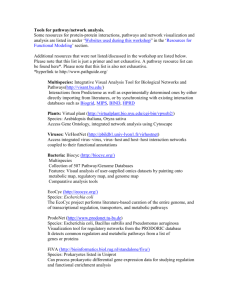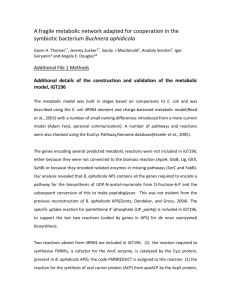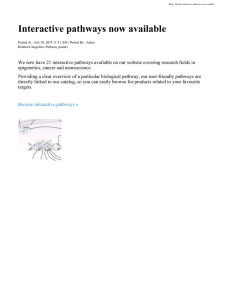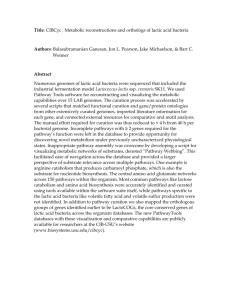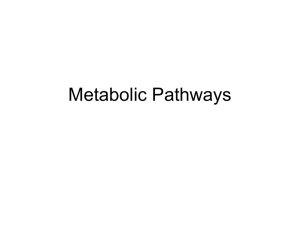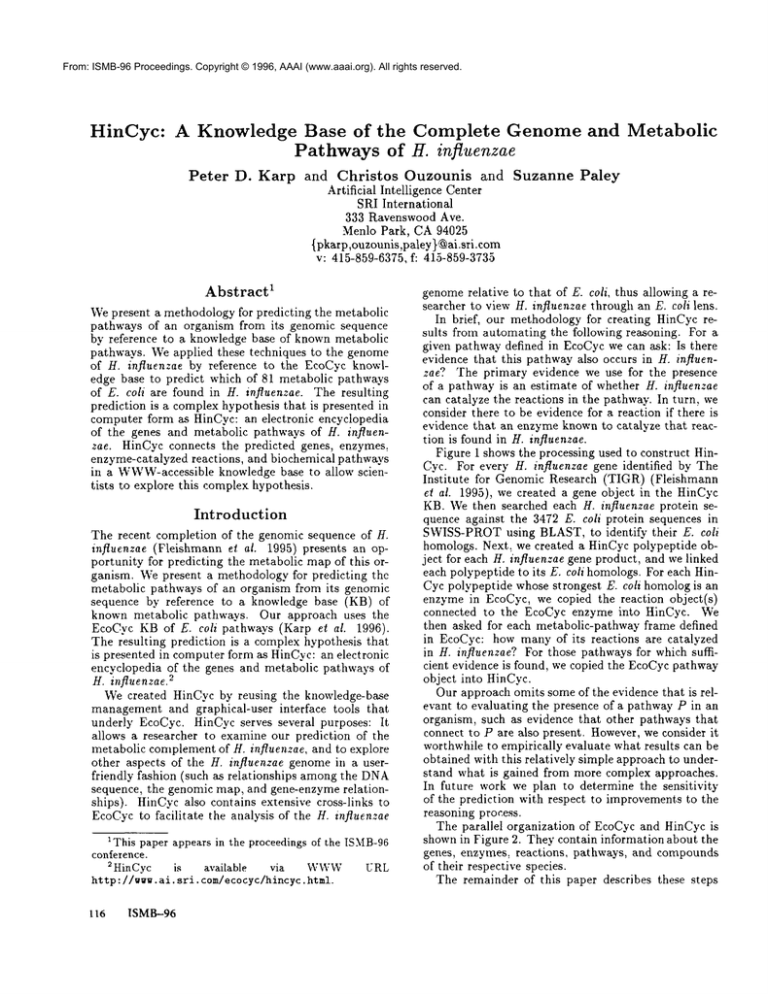
From: ISMB-96 Proceedings. Copyright © 1996, AAAI (www.aaai.org). All rights reserved.
HinCyc:
A Knowledge
Peter
D.
Karp
Base of the Complete Genome and Metabolic
Pathways of II. influenzae
and
Christos
Ouzounis
and
Artificial Intelligence Center
SRI International
333 Ravenswood Ave.
Menlo Park, CA 94025
{pkarp,ouzounis,paley}~ai.sri.com
v: 415-859-6375, f: 415-859-3735
1
Abstract
Wepresent a methodologyfor predicting the metabolic
pathways of an organism from its genomic sequence
by reference to a knowledge base of known metabolic
pathways. Weapplied these techniques to the genome
of H. influenzae by reference to the EcoCyc knowledge base to predict which of 81 metabolic pathways
of E. coli are found in H. influenzae. The resulting
prediction is a complexhypothesis that is presented in
computer form as HinCyc: an electronic encyclopedia
of the genes and metabolic pathways of H. influenzae. HinCyc connects the predicted genes, enzymes,
enzyme-catalyzed reactions, and biochemical pathways
in a WWW-accessibleknowledge base to allow scientists to explore this complex hypothesis.
Introduction
The recent completion of the genomic sequence of H.
influenzae (Fleishmann et al. 1995) presents an opportunity for predicting the metabolic mapof this organism. Wepresent a methodology for predicting thc
metabolic pathways of an organism from its genomic
sequence by reference to a knowledge base (KB)
known metabolic pathways. Our approach uses the
EcoCyc KB of E. coli pathways (Karp et al. 1996).
The resulting prediction is a complex hypothesis that
is presented in computer form as IIinCyc: an electronic
encyclopedia of the genes and metabolic pathways of
2H. influenzae.
Wecreated HinCyc by reusing the knowledge-base
management and graphical-user interface tools that
underly EcoCyc. HinCyc serves several purposes: It
allows a researcher to examine our prediction of the
metabolic complementof H. influenzae, and to explore
other aspects of the H. influenzae genome in a userfriendly fashion (such as relationships amongthe DNA
sequence, the genomic map, and gene-enzyme relationships). IIinCyc also contains extensive cross-links to
EcoCycto facilitate the analysis of the H. influenzae
1 This paper appears in the proceedings of the ISMB-96
conference.
~HinCyc
is
available
via
WWW URL
http://w~w.ai.sri.com/ecocyc/hincyc.html.
116
ISMB-96
Suzanne
Paley
genomerelative to that of E. coli, thus allowing a researcher to view H. influenzae through an E. coli lens.
In brief, our methodology for creating HinCyc results from automating the following reasoning. For a
given pathway defined in EcoCycwe can ask: Is there
evidence that this pathway also occurs in H. influenzae? The primary evidence we use for the presence
of a pathway is an estimate of whether H. influenzae
can catalyze the reactions in the pathway. In turn, we
consider there to be evidence for a reaction if there is
evidence that an enzyme knownto catalyze that reaction is found in H. influenzae.
Figure 1 shows the processing used to construct HinCyc. For every H. influenzae gene identified by The
Institute
for Genomie Research (TIGR) (Fleishmann
et al. 1995), we created a gene object in the HinCyc
KB. Wethen searched each H. influenzae protein sequence against the 3472 E. coli protein sequences in
SWISS-PROT
using BLAST,to identi~" their E. coli
homologs. Next, we created a HinCyc polypeptide object for each H. infuenzae gene product, and we linked
each polypeptide to its E. coli homologs. For each HinCyc polypeptide whose strongest E. coli homologis an
enzyme in EcoCyc, we copied the reaction object(s)
connected to the EcoCyc enzyme into HinCyc. We
then asked for each metabolic-pathway frame defined
in EcoCyc: how many of its reactions are catalyzed
in H. infuenzae? For those pathways for which sufficient evidence is found, we copied the EcoCycpathway
object into ttinCyc.
Our approach omits some of the evidence that is relevant to evaluating the presence of a pathway P in an
organism, such as evidence that other pathways that
connect to P are also present. However,we consider it
worthwhile to empirically evaluate what results can be
obtained with this relatively simple approach to understand what is gained from more complex approaches.
In future work we plan to determine the sensitivity
of the prediction with respect to improvements to the
reasoning process.
The parallel organization of EcoCyc and HinCyc is
shown in Figure 2. They contain information about the
genes, enzymes, reactions, pathways, and compounds
of their respective species.
The remainder of this paper describes these steps
SwissProt
E.coil
subset
,1
TIGRgenes
EMBL/SRI
genes
Evaluate
pathways
-<
Create
~" HinCyc
genes
Link
HinCyc
<
enzymes
to
reactions
Import
EcoCyc <
reactions,
pathways
Figure 1: The flow of data and operations
SwlssProt
Linkto
E.coil
homologs
Similarity
searchto
E.coil
Create
HinCyc
protein
complexes
in the construction
Create
HinCyc
polypeptides
of HinCyc.
GenBank
HlnCy¢
¯ Prctgins
Genes
Pathways
Compounds
Reactions
Pathways
100
Compounds
1260
Reactions
630
I ECOCyc
I
i Software
.1
I Proteins
i
520
Genes
2960
EcoCycI
Software
EcoCyc
Figure
ttinCyc
respect
number
species
2: HinCyc and EcoCyc encode the same classes of information
about their respective
organisms. Each
polypeptide is linked to all homologous EcoCyc polypeptides to facilitate
analysis of H. influenzae with
to E. coli. l:[inCyc genes and proteins are also linked to Genbank and to SWISS-PROT,respectively.
The
of objects of each type within the EcoCyc KB are also shown. Note that reactions
and compounds are not
specific,
and therefore can be transferred
from EcoCyc to HinCyc.
Karl:,
117
in more detail, and summarizes our prediction of the
H. influenzae metabolic map. WeMsodiscuss the assumptions that our method relies on, to provide an
understanding of the uncertainties in the prediction.
with probability values less than 10-~ were considered
as significant. Sequence-similarity values for pairs of
homologous sequences were obtained.
Proteins
Background
The Encyclopedia of E. coli Genes and Metabolism
(EcoCyc) is a large KBthat describes the genome and
the metabolic pathways of E. coli (Karp et al. 1996;
Karp & Paley 1996). The information in EcoCyc was
gleaned from the biomedical literature and from existing databases. The KBcurrently contains over threequarters of the knownmetabolic pathways of E. coll.
EcoCyc describes the reactions in each pathway, and
the enzymethat carries out each reaction, including its
cofactors, activators, inhibitors, and the subunit structure of the enzyme. The genes encoding tile subunits
of an enzymeare listed, as is the map position of most
genes on the E. coli chromosome.
The KB is managed using HyperTHEO -- a
Frame Knowledge Representation
System (FRS)
(Karp & Paley 1996). The EcoCyc program includes a graphical user interface that generates
displays of genes, enzymes, reactions,
pathways,
and compounds. It performs automatic layout of
metabolic pathways, and includes a genomic map
browser.
The EcoCyc GUI runs as both an XWindows application,
and as a WWW
server at
http://www.ai.sri.com/ecocyc/browser,
html.In
constructing HinCycwe reused most of the software infrastructure that supports EcoCyc, including the EcoCyc schema (Karp & Riley 1993; Karp & Paley 1994),
HyperTHEO, and the EcoCyc GUI.
Genes
We created gene objects in HinCyc for the 1743 H.
influenzae genes identified by TIGR(Fleishmann el al.
1995). 3 Additional function predictions were added as
a result of analysis by Casari et al. (Casari el al. 1995).
Frameshifts identified by continuing analyses led us to
merge several open reading frames (ORFs) and omit
34 of the original ORFs. Wefollow updates to the
sequence annotations as they becomeavailable.
Each gene object contains the location of the start
and stop codons within the complete sequence, the direction of transcription, the gene name(all of the preceding were assigned by TIGR), and a comment describing the source of the gene (from Fleischmann et
al. or Casari et al.). Each gene is linked to the Gem
bank entry that contains it, and HinCyc contains the
complete H. influenzae DNAsequence as determined
by Fleisehmann et al. (Fleishmann et al. 1995).
All H. influenzae ORFswere searched against the
collection of E. coli proteins available from SWISSPROTversion 32 (Bairoch & Boeckmann 1994), using BLAST(Altschul et al. 1990). ORFs were corrected for composition bias (unpublished). Matches
3Wedownloaded a file of gene identifications
www.tigr.org on November1, 1995.
118
ISMB-96
from
HinCyc proteins are inferred in two steps: first
polypeptides, then protein complexes. A polypeptide
object is created for each H. influenzae gene that has a
protein product -- either as given by the H. influenzae
section of SWISS-PROT
or because a gene has homology to an E. coil protein. The HinCyc polypeptide
object is linked to the gene that encodes it, to its E.
eoli homologs (in both EcoCyc and SWISS-PROT),
and to its SWISS-PROT
entry (if available).
This paper presents a conservative prediction of HinCyc pathways, because at several processing steps, we
removed inferences that might be inaccurate in order
to arrive at a relatively minimalbut morereliable prediction. For example, in this phase we removed links
from a HinCyc polypeptide to an EcoCyc polypeptide
Pt in the case where a significantly stronger homolog
P2 existed in E. coli (where P1 has a p-value at least
102° times that of P o), but P~ was not present in EcoCyc. This step removedour functional assignments for
26 H. influenzae proteins.
The second step is to create protein-complex objects.
EcoCyccontains extensive information about the quaternary structures of E. coli enzymes, and about the
enzymatic activities of the multimeric form of an enzyme versus the activities of its monomers. For example, EcoCye records that the product of the lysC
gene (2.7.2.4) acts only as a dimer. In contrast, the
products of the genes trpE and trpD (to choose a complex example) catalyze the reaction 4.1.3.27 in the form
TrpE~TrpD2,and catalyze the reaction 2.4.2.18 in the
form TrpD2.
An accurate prediction of the catalytic capabilities
of a given cell must be based on an accurate prediction
of what polypeptides are found in the cell, and of what
protein complexes those polypeptides form. There are
of course many cases involving homomultimers where
prediction is more straightforward. For example, in E.
coli the product of pykA, pyruvate kinase II (2.7.1.40),
acts as a homotetrainer. Since H. influenzae contains
a homologfor this gene, it seems reasonable to assume
that H. influenzae catalyzes this reaction. But what
if we observed that H. influe.nzae contained a homolog
to E. coli trpD, but no homologto trpE?. If we find any
component of a protein complex, should we assume
that all activities of all membersof the complex are
present (e.g., both 4.1.3.27 and 2.4.2.18)? Or should
we assume that only those activities knownto be specific to the polypeptides for which evidence exists are
present (e.g., only 2.4.2.18)? Either line of reasoning
might be correct: the gene could be missing from H.
influenzae altogether, or, less likely, the H. influenzae
trpE could have diverged beyond recognition from the
E. coli trpE.
This hypothetical trpE example is relatively easy to
resolve, because both of the enzymeactivities in ques-
tion occur in the biosynthetic pathway for tryptophan.
It seems unlikely that the cell would retain one reaction in the pathway and not the other. The situation
becomesmurkier if the reaction in question (2.4.2.18)
is also found in another pathway. This particular reaction is only used in tryptophan biosynthesis, but there
are 45 reactions in EeoCycthat are used in more than
one pathway.
Consider a more extreme (and rare) example. The
product of the E. coli lpd gene is found in three different
protein complexes (the 2-oxoglutarate dehydrogenase
complex, the gcv system, and the pyruvate dehydrogenase multienzyme complex). These enzymes carry out
five different reactions in three different pathways. The
Ipd gene does have a homologin H. influenzae; if we observe only that homolog, but homologs for none of the
other half-dozen subunits of these protein complexes,
which reaction(s) and pathway(s) would we claim
present?
The succinate dehydrogenase enzyme (1.3.99.1)
E. coli provides another interesting case. Twoof its
subunits are catalytic and two are membraneproteins.
Imagine that in tI. influenzae we found homologs for
the membraneproteins only: should we assume that H.
influenzae can catalyze 1.3.99.1, or is it morelikely that
the membrane subunits became coopted for another
use? (The actual situation is the exact opposite: H.
influenzae contains homologsfor the catalytic subunits
but not for the membranesubunits!) In any event, to
support this type of reasoning, EcoCycshould explicitly encode which subunits are responsible for each activity of an enzymecomplex, which it currently does
not (it does encode observations that a given subunit
can catalyze some reaction independent of a complex
of which it is normally part).
The actual algorithm we use to construct protein
complexes in HinCyc by analogy to protein complexes
in EcoCycis as follows. Figure 3 shows a complicated
protein complex in EcoCyc where two copies each of
subunits A and B form a complex X, which aggregates
with a single copy of the homotetramer Y, to form Z (a
number of such complexes of complexes are found in E.
colO. Imagine that H. influenzae contains polypeptides
A~ and CI as subunits.
As a minimal commitment
about the actual situation in H. influenzae, we create
only the complex ZI. Wedo not create intermediate
complexes Xt nor Y’, nor do we create a hypothetical
B’, nor do we fill in coefficients for A~ or C~ -- all on
the grounds that we do not have enough knowledge
about the conservation of subunit relationships across
species to make such detailed inferences.
HinCyc contains 1611 polypeptides, of which 1236
have at least one E. coil homolog. 277 of the polypeptides are homologous to an EcoCyc polypeptide (EcoCyc describes only proteins that are enzymes). The
277 H. influenzae polypeptides show significant homology to 313 EcoCyc polypeptides, but if we consider
only the highest-scoring E. coli homolog for each H.
influenzae polypeptide, we find 256 EcoCyc polypeptides, meaning that a given EcoCyc polypeptide is
sometimes the homolog for more than one H. influenzae polypeptide.
Of the 277 HinCyc polypeptides, 115 are monomers,
and 162 are grouped into 138 protein complexes; 108
of the latter are properly homomultimers. Of the 30
heteromultimers, 21 have no missing monomers, 6 have
one missing monomer,and 3 have more than one missing monomer:formate dehydrogenase-0 (1.2.1.2) has
of 3 subunits present, NADH
dehydrogenase I (1.6.5.3)
has 1 of 14 subunits, and hydrogenase-3 (1.12.1.2) has
1 of 5 subunits. These are all curious cases since the
majority of the subunits are missing. These three complexes were deleted in favor of a more conservative prediction.
Reactions
The next step is to determine what reactions are catalyzed by each H. influenzae enzyme. The inference we
applied is: For a HinCycenzyme complex Er, let E be
the EcoCychomologof EI. Let S be the set consisting
of E plus all subunits of E~. Let R be the union over
S of all reactions catalyzed by each element of S. Infer
~.
that all reactions in R are catalyzed by E
Note that as discussed in Section , this inference
is subject to several possible errors. If not all subunits of the E. coil protein complex are found in H.
influenzae, the H. influenzae enzyme may not have
all the activities of its E. coil counterpart. Unfortunately, EcoCycdoes not specify which subunits of an
enzyme complex are responsible for which activities
of the complex. Another potential source of error is
the fact that the preceding functional assignment step
actually ignores the functional assignments made by
TIGR and by SWISS-PROT. The TIGR assignments
are extremely difficult to utilize in a computational environment since they are purely textual and omit EC
numbers. The SWISS-PROT
entries, however, include
EC numbers. Wetherefore compared the EC numbers
that we inferred using the sequence-similarity search
against E. coil proteins, to the ECnumbers in SWISSPROT.
Of all genes identified by TIGR, SWISS-PROT
has
assigned 439 ECnumbers to the polypeptide products
of 429 genes (there are roughly 10 multifunctional enzymes in H. influenzae). For 213 of the 429 HinCyc
polypeptides, their EC numbers existed in EcoCyc,
and EcoCyc describes the enzymeassociated with that
EC number. The remainder represent either reactions
that do not occur in E. coli, incomplete information
in EcoCyc, or partially specified EC numbers (for example, numbers such as 1.2.3.- are used to informally
indicate that the class of the reaction is knownbut
the enzymecommittee has not yet assigned an official
number).
Using BLAST,we identified 261 of the 1519 genes
that have homologous polypeptides in EcoCyc. We
actually identified many more E. coli homologs, but
the polypeptides were not present in EcoCyc, either
because they are not involved in central metabolism
or because EcoCyc is incomplete. Of the 261 Hin-
Karp
119
2
(a)
(b)
A
/X~
.,.--
B
Z’~
"\
\Y
~
AI
,Z’
<C
C
Figure 3: (a) A multienzyme complex in E. coil; (b) the analogous complex in II. influenzae.
Cyc polypeptides, 225 of them have EcoCyc homologs
that have associated EC numbers. We can therefore compare the EC numbers that would be inferred
for these 225 HinCyc polypeptides with the EC numbers supplied by SWISS-PROT
for the preceding 213
HinCyc polypeptides. The intersection
of these two
sets of polypeptides yields 201 polypeptides. The EC
numbers matched in 193 cases. Of the eight conflicting cases, one shows a match between the TIGR and
SWISS-PROTfunctional assignment and our second
choice E. coil homolog.Twoof the cases involve partial
EC numbers that match, and we found that the textual descriptions also match. The remaining five cases
are complete mismatches, and it remains to be determined which functional assignment is the correct one.
There could be other conflicts between our functional
assignments and those of TIGR and SWISS-PROT,
but these cannot be determined automatically.
In summary, our functional assignments are consistent with the SWISS-PROTassignments.
The advantage of not simply using the SWISS-PROT
assignments is that we are able to infer additional functions
for enzymes whose function is not described in SWISSPROT,or whose function has not yet been given an EC
number, but is contained in EcoCyc.
It is also interesting to determine which reactions
are present in H. influenzae, but apparently do not occur in E. coll. Wecomputeda list of all H. influenzae
genes to which SWISS-PROThas assigned complete
EC numbers, but which are not present in E. coil (as
determined by EcoCyc). This procedure resulted in
a list of seven ECnumbers that are present in H. influenzae for which there is no evidence of occurrence in
E. eoli. Theyare: 2.3.1.31, 2.7.2.2, 3.1.21.4, 3.4.21.72,
3.4.24.57, 4.1.3.6, and 6.2.1.22. The accuracy of this
result is limited by the fact that EcoCycdoes not yet
contain information about all enzymes that are known
to occur in E. coil, nor is the full set of enzymesthat
occur in E. coli known.
Pathways
Our pathway predictions for H. influenzae are shown
in Tables 1, 2 and 3, grouped roughly by the degree
of evidence for the pathways. Table 1 shows those E.
eoli pathwayswhose presence in H. influenzae is likely
since almost all of the reactions for these pathwaysare
catalyzed by H. mfluenzae. Each row in these tables
gives a pathway name followed by two colunms of evidence. Column1 lists the (unreduced) fraction of those
120
ISMB-96
reactions in the pathway for which an enzymehas been
inferred to occur in H. influenzae. For example, in the
first line of Table 2, eight of the thirteen reactions of
the E. coli fermentation pathway can be catalyzed by
H. influenzae.
The third columnprovides evidence against the presence of a pathway. Of the eight reactions of fermentation that E. influenzae can catalyze (Table 2, line 1),
five of those reactions are also used in four other pathways. This evidence could support an argument that
fermentation does not occur in H. influenzae, since
only three of the fermentation reactions observed in
H. influenzae are unique to that pathway-- their presence cannot be explained by participation in a different
pathway. Column3 is more relevant in explaining away
those pathways for which only marginal evidence exists. Consider the TCAcycle in Table 2: although we
have evidence that H. influenzae can catalyze four of
its nine reactions, two of those reactions (1.3.99.1 and
1.1.1.37) are used in two different pathways(note that
the numberof reactions (numerator) in the second column is always computed relative to the reactions in
the (numerator of) the first column-- those for which
there is evidence that they occur in H. influenzae).
Therefore, only two unique TCAcycle reactions are
found in H. influenzae, which may be remnants of a
lost TCAcycle. On the other hand of course, the remaining four enzymes (which catalyze five reactions)
may be discovered at a later time.
Overall, H. influenzae has a fairly complete set of
biosynthetic pathways for amino acids, nucleotides,
and fatty acids. Surprisingly, a imlnber of cofactorbiosynthesis pathways appear to be missing from H.
influenzae. Also missing are several catabolic pathways for carbohydrates, which could be linked to the
growth-mediumversatility of this organism.
Table 3 should be considered the least, solid prediction; because we used more conservative evidence in
makingthese predictions, a lack of evidence for a given
pathway should not be considered strong evidence that
the pathway does not occur. That is, were we performing a more liberal prediction, some evidence would no
doubt, appear for some of these pathways.
Limitations
The pathway predictions
computed by our methods
should be viewedas tentative hypotheses that are likely
to contain errors, and that will undergo revision over
time as better input data and better prediction meth-
I Pathway
purine biosynthesis
pyrimidine ribonucleotide/ribonucleoside
metabolism
histidine biosynthesis
threonine biosynthesis
valine biosynthesis
fatty acid elongation, unsaturated
deoxyribonucleotide metabolism
leucine biosynthesis
pyruvate dehydrogenase
serine biosynthesis
glycogen biosynthesis
peptidoglycan precursor biosynthesis
phosphatidic acid synthesis
glucosamine catabolism
glycine biosynthesis
cysteine biosynthesis
removal of superoxide radicals
aspartate biosynthesis
$1utamine biosynthesis
peptidoglycan biosynthesis
$1ycolysis
biosynthesis of lysine and diaminopimelate
fatty acid biosynthesis, initial steps
methionine biosynthesis
menaquinone biosynthesis
fatty acid oxidation pathway
non-oxidative branch of the pentose phosphate pathway
formylTHF biosynthesis
glycerol metabolism
fatty acid elongation, saturated
isoleucine biosynthesis
nucleotide metabolism
deoxypyrimidine nucleotide/side
metabolism
lipid-A-precursor biosynthesis
proline biosynthesis
folk acid biosynthesis
gluconeogenesis
riboflavin,
FMNand FADbiosynthesis
oxidative branch of the pentose phosphate pathway
ppGpp metabolism
methyl-donor molecule biosynthesis
alanine biosynthesis
tyrosine biosynthesis
phenylalanine biosynthesis
pyruvate oxidation pathway
ribose catabolism
Evidence
12t12
11
10110
5 15
5 ¢5
f4
/4
/4
13
/3
/3
/3
/2
/2
/2
’2
’2
’1
’1
’9
’9
’9
7 ’8
7 r8
6 ’7
6 ’7
Other
5 76
13/16
4 /5
4/5
4/5
22/29
9 /12
6 /8
3 /4
11 q5
’12
pwys
2/1
3/2
o/o
3/1
2/2
3/1
2/1
o/o
o/o
1/1
o/o
2/2
o/o
o/o
2/2
o/o
o/o
o/o
o/o
1/1
6/2
2/1
o/o
5/3
o/o
o/o
3/2
lO/5
o/o
3/1
o/o
4/2
3/2
2/1
o/o
6/2
6/2
~9
0/0
~3
~3
1/1
0/0
~3
~3
¢3
2 13
2 I3
2 I3
Table 1: We find strong evidence that these E. coli pathways occur in H. influenzae.
meant by a given pathway name, find that pathway through the EcoCyc WWW
server
2/1
2/2
1/1
1/1
2/1
2/2
To determine exatly
(see Section 2).
what is
Karp
121
Evidence
I Pathway
fermentation
8 1/13
glucose 1-phosphate metabolism
3/5
tryptophan biosynthesis
a/5
KDObiosynthesis
3/5
glyoxylate degradation
a/5
/deoxy)ribose phosphate metabolism
5 /9
pyrimidine biosynthesis
3/6
Entner-Doudoroff pathway
1 /2
4-aminobutyrate degradation
1 /2
aspar~tginebiosynthesis
1 /2
L-alanine degradation
1 /2
glycine cleavage
1 /2
TCAcycle
4/9
arginine biosynthesis
3/8
I
Other
pwys
514
211
010
211
111
413
111
010
0/0
010
111
i11
2/2
010
Table 2: Wefind moderate evidence that the these E. coli pathways occur in H. influenzae.
ods become available. Our method is limited by the
following factors.
The quality of the input data. Incorrect identification of H. influenzae ORFs, or incorrect functional assignments could lead to false-negative or falsepositive pathway predictions.
For example, the incorrect identification of a given H. influenzae enzyme
would provide incorrect evidence for the pathway containing that enzyme.
Incomplete datasets.
Many H. influenzae genes
do not have functional assignments, the sequence of E.
coli has not been completed, and EcoCyc does not describe a number of E. coli enzymes and pathways (both
knownand unknown). These factors would cause falsenegative predictions. For example, if a given enzyme
had been sequenced in H. influenzae but not in E. eoli.
the H. influenzae enzymewould not be given a E. coli
homolog, would not have a reaction inferred for it, and
therefore would not provide evidence that its pathway
occurs in H. influenzae.
Pathways unique to H. influenzae.
Our method
makes no prediction regarding pathways that exist in
H. influenzae but not in E. coli since our available
pathway KBspans E. coli only. Wedo, however, identi~’ reactions that are catalyzed in H. influenzae but
not E. coll. This limitation would be more significant
when analyzing organisms with a greater evolutionary
distance from E. coli, in which we would expect to
find a larger number of pathways not found in E. coli
-- although just how great the metabolic variation is
amongdifferent organisms is an open question. These
novel pathways could be of two forms: novel implementations (e.g., although E. coli can synthesize methionine, another organism might use a different pathway
to synthesize methionine), and novel functions (e.g.,
biosynthetic pathway to synthesize a compound that
E. coli is unable to synthesize by any means).
It is not always possible to evaluate metabolic reconstructions from whole genomes. The metabolic pathways for H. influenzae are not well studied experimentally. The pathways of M. genitalium, whose genome
has also been sequenced, are better understood, but
122 ISMB-96
are muchsimpler and therefore less interesting to predict because of the parasitic lifestyle of mycoplasmas.
Related
Work
Gaasterland
and Selkov defined the problem of
metabolic prediction from sequence data one year
ago in a comprehensive paper (Gaasterland ~z Selkov
1995). They considered a broad range of evidence
and reasoning strategies that bear on this problem,
such as considering experimentally determined growthmediumrequirements of the organism, introducing default pathways from evolutionarily related organisms,
and introducing new pathways to produce or consume
"dangling compounds"in existing pathways.
Our method does not consider many of these sources
of evidence, although we do consider a number of complications that they do not address, such as multimeric
enzymes, reactions that occur in multiple pathways,
and the types of evidence that are supplied by sequencing projects. Although our method uses less evidence,
it is still able to makecomprehensivepredictions.
Wedo question the practice of introducing default
pathwaysduring the interpretation process, since it is
unclear from howremotea taxon it is valid to retrieve a
default pathwayfrom, that is, howcan we rule out postulating by default that every knownmetabolic pathway occurs in a given organism? It would be useful
to gather data regarding the prior probability of every
metabolic pathwayin different regions of the evolutionary tree, to guide the introduction of default pathways.
Discussion
A number of issues arose in the course of this project
that, if resolved, wouldmakesimilar analyses easier in
the future.
Several questions arise regarding enzymecomplexes:
To what degree are quaternary protein structures conserved through evolution? If several polypeptides are
subunits of a complex in one species, how likely are
homologs of those polypeptides to be associated in a
Pathway
Evidence
U DP-N-acetyl$1ucosaminebiosynthesis
NADphosphorylation and dephosphorylation
dTDP-rhamnosebiosynthesis
galactose, gaiactoside and glucose catabolism
pyridoxal 5’-phosphatebiosynthesis
glyoxylate cycle
pyridine nucleotide synthesis
1 /6
polyamine biosynthesis
1 /6
biosynthesis of proto- and siroheme
2 /13
thiamin biosynthesis
1 /9
pantothenate and eoenzymeA biosynthesis
1 /10
glycogen catabolism
0 /7
glycolate metabolism
o/6
D-ghcuronate catabolism
fucose catabolism
o/5
rhamnose catabolism
0/5
sulfate assimilation pathway
0/4
D-gMacturonatecatabolism
0/4
propionate metabolism, methylmaionyl pathway
0/3
degradation of short-chain fatty acids
glutamate biosynthesis
I
Table 3: Wefind little
Other pwys I
1
0
0
2
0
1/1
0/0
0/0
0/0
0/0
0/0
0/0
0/0
0/0
0/0
0/0
0/0
0/0
0/0
0/0
0/0
orno evidence that these E. coli pathways occur in H. influenzae.
related species? Howdoes enzyme activity vary as a
function of changes in quaternary structure?
EC numbers proved to be very useful in this project
because they allowed automatic cross-checking of the
functions of our computed E. coli homologs with the
functional assignments in SWISS-PROT.We strongly
suggest that future sequencing projects supply EC
numbers with their functional predictions. We also
note that the EC system is currently quite incomplete:
EcoCyc describes 87 enzymes whose activities do not
yet have an EC number (about 20% of the enzymes in
EcoCyc). Furthermore, it would be useful to have an
EC-like system for other types of proteins besides enzymes(e.g., transport proteins), to facilitate reasoning
about their functions.
Enzymevariability complicates metabolic prediction
in several ways. For example, if H. influenzae employs
an enzymeE to catalyze a reaction R that is catalyzed
by an enzyme E~ in E. coli but E has no sequence
similarity to E’ (or to any other known enzyme that
catalyzes R), how can we recognize that H. influenzae
can catalyze R? Variability in substrate specificity can
also introduce false positive or negative predictions:
even if E does have sequence similarity to E’, E might
have evolved to carry out reaction R’ instead of R,
or to carry out reaction R" in addition to R, both of
whichcases are difficult to predict.
This project raises a host of fundamental questions
about the process of predicting gene function by running similarity searches in sequence databases. Those
functional predictions are the principal input of our
metabolic-prediction techniques, and of those of Selkov
and Gaasterland, and therefore these methods are intimately dependent on these predictions. The following
questions arise.
Howcan we assess the reliability of a functional prediction based on a similarity search? The p-value reported by a program such as BLASTis the probability that a similarity between two sequences arose
by chance. It is not the probability that the two sequences share the same function! The relationship between these probabilities will vary from one protein
family to another, and across species, but it would be
useful in deciding what predictions are most likely to
be correct.
Whyis it that the functional predictions that are
published by many of the sequencing projects do not
contain estimates of reliability? Even if programssuch
as BLASTcannot compute such estimates automatically, the scientists whomakethe final assignment after
looking at multiple matching sequences, alignments,
profile searches, and so forth, are in a goodposition to
makeat least a rough estimate of its reliability.
Howcan we resolve conflicting functional predictions
for genes? Given that there is uncertainty in functional assignments, whynot publish several alternative
predictions for a gene if various functions are reasonably likely? Such predictions would be useful to our
method. Imagine if our method were told that a given
gene could catalyze either reaction R1 or R2, where
R1 is found in pathway P1 and R2 is found in P2. If
there were much more other evidence for the presence
of P2 than P1, we might decide that R= is the more
likely interpretation. In contrast, we might have assigned greater likelihood to the presence of P1, had
the original functional assignment been R1 only.
To what degree does absence of a similarity match
imply absence of a function in a complete genome?
Fleischmann et al. found that no H. influenzae genes
match any of the known sequences for four of the enKarp
123
zymes in the TCAcycle (Fleishmann el al. 1995). If
we could transform the lack of a similarity match into
a probability that these enzymes were truly missing
from H. influenzae (as opposed to being undetected
either because of sequence divergence, or independent
evolution of the same function), we could give a better
estimate that the TCAcycle itself is absent. Such an
estimate might be based on the number of known sequences of a given enzyme, their sequence variation as
a function of evolutionary distance, and the evolutionary distance between the organism of interest and the
closest knownsequence.
Summary
We have presented techniques for predicting the
metabolic map of an organism from its predicted gene
products. We used those techniques to predict the
metabolic map of H. influeuzae by analogy to the
metabolic map of E. colt. Out of 81 metabolic pathways that occur in E. colt, we find strong evidence for
the presence of 46 of the pathwaysin H. influenzae; we
find mediumevidence for the presence of 14 pathways,
and we find little or no evidence for 21 pathways. Our
prediction is presented as HinCyc, a KBthat links the
predicted genes of H. influenzae to the predicted products of those genes; enzymeproducts are linked to the
reactions that they are predicted to catalyzed, which in
turn are linked to the pathways that contain them. Scientists can employ IlinCyc to examine gene-function
relationships in H. influenzae, and can further analyze
H. influenzae relative to E. colt because of extensive
links between HinCyc and EcoCyc.
Acknowledgments
We acknowledge help and support by Georg Casari
(EMBL-Heidelberg) during the initial phase of this
work. This research was supported by SmithKline
Beecham Pharmaceuticals. The EcoCyc software upon
which HinCyc is based was supported by grant 1-R01RR07861-01from the National Center for Research Resources, and by grant R29-LM-05413-01A1from the
National Library of Medicine. CO is supported by
a long-term postdoctoral fellowship from the Human
Frontiers Science Program Organization. The contents
of this article are solely the responsibility of the authors.
References
Altschul, S.; Gish, W.; Miller, W.; Myers, E.; and
Lipman, D. 1990. Basic local alignment search tool.
J Mol Bio 215:403--410.
Bairoch, A., and Boeckmann, B. 1994. The SWISSPROTprotein sequence data bank: current status.
Nucleic Aczds Research 22:3578-3580.
Casari, G.; Andrade, A.; Bork, P.; Boyle, J.; Daruvar. A.; Ouzounis, C.; Schneider, R.; Tamames,J.:
Valencia, A.; and Sander, C. 1995. Challenging times
for bioinformatics. Nature 376:647-648.
124 1SMB---96
Fleishmann, R.; Adams, M.; White, O.; Clayton, R.;
Kirkness, E.; Kerlavage, A.; BuR, C.; Tomb, J.-F.;
Dougherty, B.; Merrick, J.; McKenney,K.; Sutton,
G.; FitzHugh, W.; Fields, C.; Gocayne, J.; Scott, J.;
Shirley, R.; Liu, L.-I.; Glodek, A.; Kelley, J.; Weidman, J.; Phillips, C4 Spriggs, T.; Hedblom, E.:
Cotton, M.; Utterback, T.; Hanna, M.; Nguyen, D.;
Saudek, D.; Brandon, R.; Fine, L.; Fritchman, J.;
Fuhrmann, J.; Geoghagen, N.; Gnehm, C.; McDonald, L.; Small, K.; Fraser, C.; Smith, H.; and Venter,
J. 1995. Whole-genome random sequencing and assembly of Haemophilus influenzae. Science 269:496512.
Gaasterland, T., and Selkov, E. 1995. l:teconstruction of metabolic networks using incomplete information. In Rawlings, C.; Clark, D4 Altman, R.; Hunter,
L.; Lengauer, T.; and Wodak, S., eds., Proceedings
of the Third International Con]ere.nce on Intelligent
Systems for Molecular Biology, 127-135. MenloPark,
CA: AAAIPress.
Karp, P., and Paley, S. 1994. Representations of
metabolic knowledge: Pathways. In Altman, R.;
Brutlag. D.; Karp, P.; Lathrop, R.; and Searls, D.,
eds., Proceedings of the Second lnternalional Conference on Intelligent Systems for Molecular Biology,
203-211. Menlo Park. CA: AAAIPress.
Karp, P., and Paley, S. 1996. Integrated access to
metabolic and genomic data. Journal of Computational Biology 3(1):191-212.
Karp, P., and Riley, M. 1993. Representations of
metabolic knowledge. In Hunter, L.; Searls, D.; and
Shavlik, J., eds., Proceedings of the First International Conference on Intelligent Systems for Molecular Biology, 207-215. Menlo Park, CA: AAAIPress.
Karp, P.; Riley, M.; Paley, S.; and Pellegrini-Toole,
A. 1996. EcoCyc: Electronic encyclopedia of E. colt
genes and metabolism. Nuc. Acids Res. 24(1):32-40.

